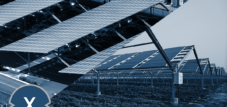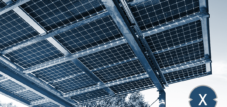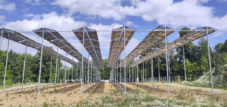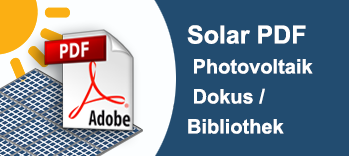Shade resistant: What does shade resistance really mean for solar modules? More performance even in the shade?
Language selection 📢
Published on: October 26, 2024 / update from: October 26, 2024 - Author: Konrad Wolfenstein

Shade resistant: What does shade resistance really mean for solar modules? More performance even in the shade? – Image: Xpert.Digital
🌞🔋 What does shading resistance really mean for solar modules? A realistic look at performance and technology
⚡🏬 Many people have false ideas about the term “shading -resistant”. It is often assumed that such solar modules can still deliver high energy yields even with permanent shading. But what is actually behind this technology, and why can even shade -resistant modules not accomplish miracles if they are permanently in the shade?
🌳🌇 The problem of shading
Shading is one of the biggest enemies of photovoltaic systems. It occurs when parts of a solar panel are shaded by external objects such as trees, buildings, chimneys or antennas. Even small shadows can lead to significant reductions in performance. This is because the solar cells within a module are usually connected in series. When a cell receives less light, it acts like a resistor and reduces the current flow throughout the string.
⚙️💡 What exactly does shading resistance mean?
Shading resistance refers to the ability of a solar module or photovoltaic system to minimize the negative effects of partial shading. Special technical measures can prevent a shaded cell or module from excessively affecting the performance of the entire system.
🛠️🚀 Technologies to improve shading resistance
1. Bypass diodes
Bypass diodes are often integrated into modern solar modules. These make it possible to bridge shaded cells so that the current flow is maintained in the unshaded cells. This reduces power loss.
2. Optimized cell interconnection
Some manufacturers rely on optimized interconnection of the solar cells within the module. Instead of connecting all the cells in a row, they are divided into smaller groups. This means that shading only affects part of the module.
3. Performance optimizer
Power optimizers are electronic devices that are attached to each module. They maximize energy yield by setting the optimal operating point of each individual module independently. This allows you to further reduce the effects of shading.
4. Micro inverter
Similar to power optimizers, microinverters are installed at the module level. They convert the direct current of each module directly into alternating current, enabling independent power measurement and optimization.
Suitable for:
🛑🔍 The limits of shading resistance
Despite these advanced technologies, there are clear limitations. Even shade-resistant modules cannot perform magic if they are permanently in the shade. Without sufficient sunlight, no solar module can generate energy. Shading resistance can mitigate the effects of partial shading, but it cannot compensate for the lack of light.
🚫❌ Common misunderstandings
A common misunderstanding is the assumption that shading-resistant modules still work efficiently even when completely shaded. However, this is not the case. The physics of photovoltaics is based on the photoelectric effect, in which light energy is converted into electrical energy. Without light there is no energy production.
📈💭 Realistic expectations for solar systems
It is important to have realistic expectations of the performance of solar systems. Shade resistance does not mean that a system will provide maximum performance under all conditions. Instead, it ensures that the system works better under suboptimal conditions than without these technologies.
🗺️🔧 Tips for minimizing shading
1. Careful planning
When planning a photovoltaic system, a shading analysis should be carried out. In this way, potential sources of shading can be identified and taken into account.
2. Location selection
Choose a location with as little shading as possible. Pay attention to surrounding buildings, trees and other objects.
3. Customizable mounting systems
With flexibly adjustable mounting systems, modules can be aligned so that they are exposed to less shading.
4. Regular maintenance
Trees grow and can become new sources of shade over time. Regular maintenance and tree pruning can help here.
☁️🔍 Reduce the effects of partial shading
Shading resistance is a valuable property of modern solar modules that helps reduce the effects of partial shading. However, it is not a panacea. Permanent and complete shading cannot be completely compensated for even with the best technology.
For optimal results, solar systems should be planned and installed in such a way that shading is minimized. Shading resistance should be seen as a complementary measure to improve system efficiency under less than ideal conditions.
By better understanding the actual performance and limitations of shade-resistant modules, system operators can set realistic expectations and get the most out of their photovoltaic system.
📣 Similar topics
- 🌞 What does shade resistance really mean?
- 🏠 The problem of shading with solar modules
- ⚙️ Technologies to improve solar performance
- 🌿 Tips for minimizing shading
- 🔋 Increased efficiency through performance optimizers
- 🌤️ Realistic expectations for solar systems
- 🛠️ Advantages of bypass diodes in shading
- 🌳 Location selection for minimal shading
- 💡 Optimized cell interconnection for better results
- 📉 The limits of shading resistance
#️⃣ Hashtags: #shading #solar modules #efficiency #technology #renewableenergy
🎯🎯🎯 Benefit from Xpert.Digital's extensive, fivefold expertise in a comprehensive service package | R&D, XR, PR & SEM

AI & XR 3D Rendering Machine: Fivefold expertise from Xpert.Digital in a comprehensive service package, R&D XR, PR & SEM - Image: Xpert.Digital
Xpert.Digital has in-depth knowledge of various industries. This allows us to develop tailor-made strategies that are tailored precisely to the requirements and challenges of your specific market segment. By continually analyzing market trends and following industry developments, we can act with foresight and offer innovative solutions. Through the combination of experience and knowledge, we generate added value and give our customers a decisive competitive advantage.
More about it here:
👷♂️🔧 Comparison: Bypass diodes and power optimizers
🔋 Bypass diodes and power optimizers in solar systems ☀️
Bypass diodes and power optimizers are two technologies used in solar systems to minimize the negative effects of shading. Both have specific benefits and applications.
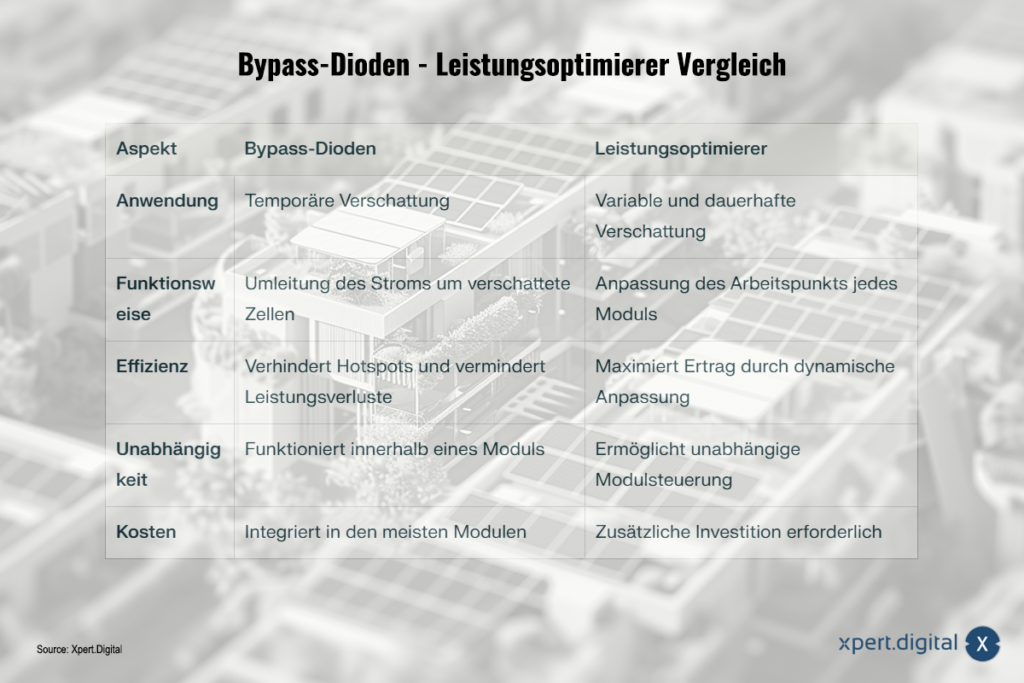
A realistic look at performance and technology / comparison: bypass diodes and power optimizers - Image: Xpert.Digital
😊 Advantages of bypass diodes
Avoiding hotspots
Bypass diodes direct current around shadowed or defective cells. This prevents the formation of hotspots that can cause damage due to overheating.
Protection against power losses
They isolate affected cells and allow the other cells in the module to continue working efficiently, maintaining overall performance.
Increasing reliability
By limiting damage and power loss, bypass diodes contribute to the longevity and reliability of solar modules.
Efficiency with temporary shading
Particularly effective for temporary shading caused by clouds.
🌟 Benefits of performance optimizers
Individual module optimization
Power optimizers individually adjust the operating point of each module to operate it near its Maximum Power Point (MPP). This maximizes energy yield even under suboptimal conditions.
Independent module control
They allow each module to work independently of the others, which is particularly beneficial when some modules are shaded and others are not.
Yield maximization with variable shading
Power optimizers are particularly effective when shading conditions change throughout the day. They prevent selective shading from affecting the entire string.
⚡🌤 Bypass diodes protect against temporary shading, power optimizers maximize yield under variable conditions
Bypass diodes are ideal for avoiding hotspots and ensuring module reliability during temporary shading. Performance optimizers, on the other hand, offer a more comprehensive solution for variable and permanent shading by optimizing the performance of each module individually. Both technologies complement each other and can be combined depending on the specific requirements of a solar system.
📣 Similar topics
- 🌞 Efficient solutions for shading: bypass diodes and power optimizers
- ⚡ Hotspot avoidance and reliability with bypass diodes
- 🔋 Power optimizer for maximum solar energy yields
- 🌤 Bypass diodes and power optimizers in comparison
- 🌟 Module optimization under variable conditions
- 🔧 Protection and efficiency in solar systems: Two key technologies
- 🌥 Independent module control in the event of shading
- 🔍 Preventing power losses in solar modules
- 🛡️ Longevity and reliability thanks to bypass diodes
- ✨ Combined use for optimized solar system performance
#️⃣ Hashtags: #solar technology #bypass diodes #power optimizer #shading management #energy efficiency
We are there for you - advice - planning - implementation - project management
☑️ Industry expert, here with his own Xpert.Digital industry hub with over 2,500 specialist articles
I would be happy to serve as your personal advisor.
You can contact me by filling out the contact form below or simply call me on +49 89 89 674 804 (Munich) .
I'm looking forward to our joint project.
Xpert.Digital - Konrad Wolfenstein
Xpert.Digital is a hub for industry with a focus on digitalization, mechanical engineering, logistics/intralogistics and photovoltaics.
With our 360° business development solution, we support well-known companies from new business to after sales.
Market intelligence, smarketing, marketing automation, content development, PR, mail campaigns, personalized social media and lead nurturing are part of our digital tools.
You can find out more at: www.xpert.digital - www.xpert.solar - www.xpert.plus







